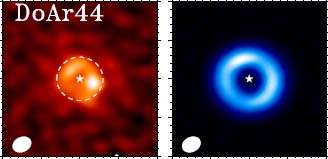Planetary influences on young stellar disks

A newborn star typically has a disk of gas and dust from which planets develop as the dust grains collide, stick together and grow. Stars older than about five million years lack evidence for these disks, however, suggesting that by this age most of the disk material has either been converted into planets or smaller bodies, accreted onto the star, or dispersed from the system. Transition disks bridge this period in disk evolution: They have not yet been disbursed, and warmed by the star, can be detected at infrared or millimeter wavelengths. Their infrared colors can be used to characterize their properties. They often show inner dust cavities, which astronomers have sometimes interpreted as evidence of the presence of planets that have cleared out their orbits.
The models of planet-disk interactions, however, indicate that dust cavities are only an indirect consequence of planet clearing. What actually seems to occur is that the planet creates a gap in the gas, and the gas distribution at its outer edges then traps the small dust grains and produces a dust ring that is frequently asymmetric. There is some uncertainty in this picture because other mechanisms could produce a dust cavity or dust ring, including selective evaporation of dust grains by starlight, or instabilities in the dust ring itself. Determining the gas density inside the cavity can help to distinguish between these mechanisms.
CfA astronomer Sean Andrews and his colleagues used the ALMA millimeter-wavelength telescope array to study transition disks in four relatively nearby young stars. This powerful new facility can measure dimensions in these disks as small as twenty-four astronomical units (one AU is the average distance of the Earth from the Sun), and can do so for both the small dust grains and the warm gas. In all four disks the scientists were able to model the gas distribution. They found that the gas cavity was as much as three times smaller than the dust cavity, and that the gas density inside the cavity drops by at least a factor of one thousand compared to the surface density. The results strongly suggest that the cavities were indeed produced by orbiting planets.
More information: "Resolved Gas Cavities in Transitional Disks Inferred from CO Isotopologs With ALMA," N. van der Marel, E.F. van Dishoeck, S. Bruderer, S.M. Andrews, K.M. Pontoppidan, G.J. Herczeg, T. van Kempen, and A. Miotello, A&A, in press (2015). arxiv.org/abs/1511.07149
Provided by Harvard-Smithsonian Center for Astrophysics





















